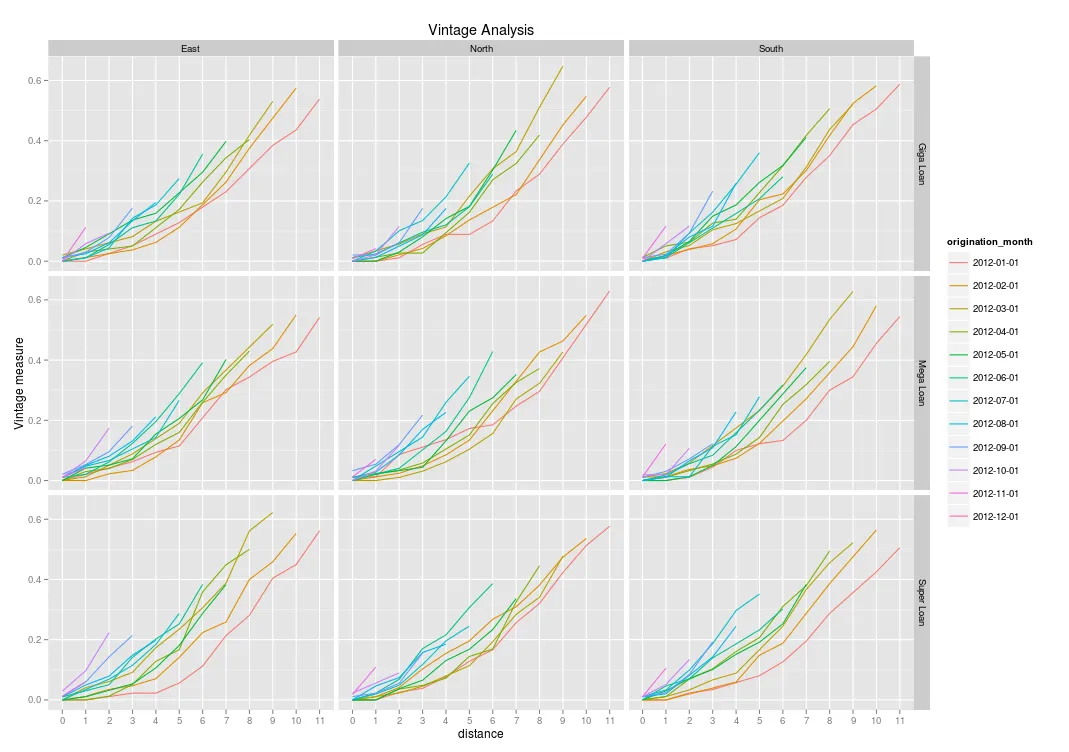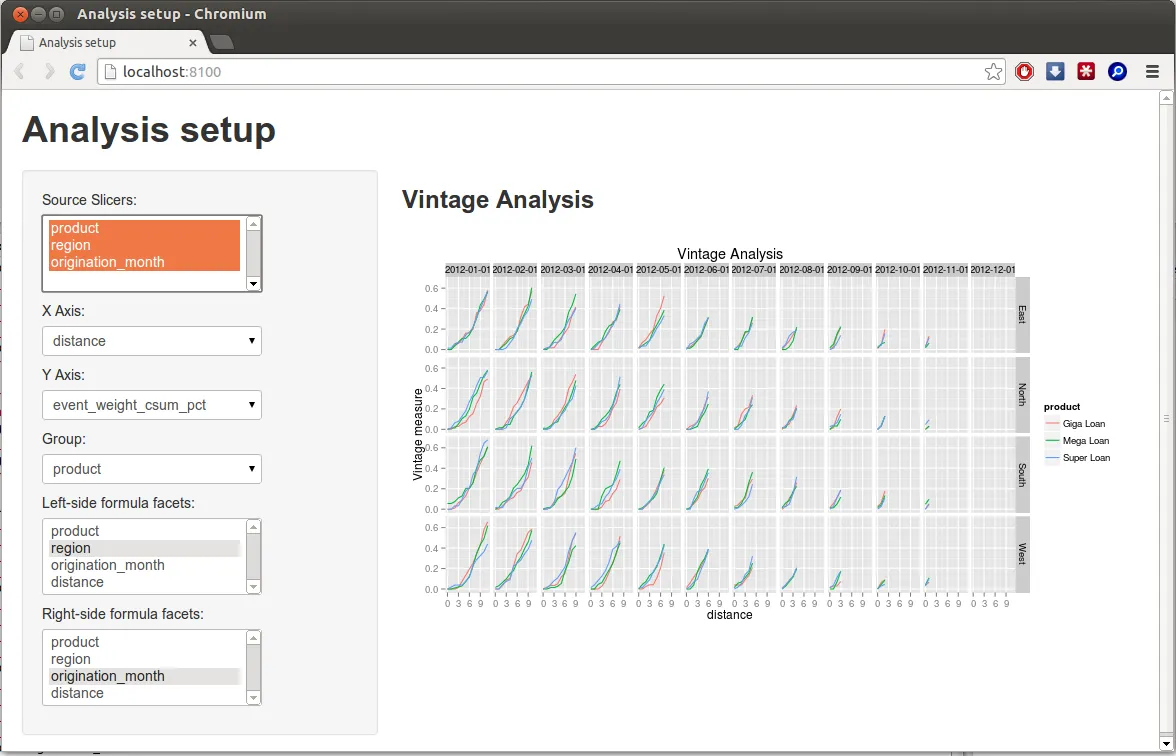现实描述: 我们有一些项目清单。每个项目都有很多账户。您可以在每个账户上执行许多操作。我定义了以下简化的维度和事实表:
Dimensions and attributes:
Project
project_key
project_name
industry
number_of_accounts
Distance
distance_key
distance_in_months
distance_in_quarters
Account
account_key
project_key
account_id
Fact Table and attributes:
Action_Fact_Table
project_key
distance_key
account_key
action_id
现在,我想使用赔付三角法来分析数据(可能不是真正的赔付三角形式,但方法是相同的)。最简单的三角形如下:
Distance in Months
Project name| 1 2 3 4 5 6 7 8 9 10
-------------------------------------------------------------------------
Project1 | 5 10 15 20 25 30 35 40 45 50
Project2 | 7 14 21 28 35 42 49 56 63
Project3 | 2 5 8 11 14 20 25 30
Project4 | 0 2 5 10 18 23 40
Project5 | 5 12 18 20 21 30
按行动作数量的累加和,显示距离项目开始日期的月份间隔。你可以使用季度间隔(或在间隔维度中定义的任何其他周期)创建类似的三角形。
您还可以为项目维度中不同层次创建三角形,例如行业(Project1-Project3 = Industry1,Project4-Project5 = Industry2):
Distance in Months
Project name| 1 2 3 4 5 6 7 8 9 10
-------------------------------------------------------------------------
Industry1 | 14 29 44 59 74 92 109 126 108 50
Industry2 | 5 14 23 30 39 53 40
还有更高级的赔付三角形,其中您将动作的累加值除以账户数量。假设我们的项目有以下账户数量:
Project_name number_of_accounts
-----------------------------
Project1 100
Project2 100
Project3 100
Project4 100
Project5 200
然后我想得到以下三角形:
Distance in Months
Project | 1 2 3 4 5 6 7 8 9 10
------------------------------------------------------------------------
Project1 | .05 .01 .15 .20 .25 .30 .35 .40 .45 .50
Project2 | .7 .14 .21 .28 .35 .42 .49 .56 .63
Project3 | .2 .5 .8 .11 .14 .20 .25 .30
Project4 | .0 .2 .5 .10 .18 .23 .40
Project5 | .05 .06 .09 .10 .105 .15
对于希望比较项目及其活动的情况,其中一个项目中的账户数量与其他项目不同,这种情况下,特别有用。问题是是否可能在OLAP中创建这样的计算。我曾考虑过在项目表中使用“项目中的账户数量”,但无法弄清楚如何实现。另一个选项是在账户维度中汇总数据。我在谷歌上也没有找到任何有用信息,可能是因为我问的问题不正确。
这个问题的解决方案在许多行业都广泛适用,特别是在保险和银行业。它可以应用于所有具有长时间性能窗口并可由定义明确、可比较的单位批次跟踪的过程中。
(我们正在使用PostgreSQL、Saiku,在Schema Workbench中定义了立方体)
测试数据(PostgreSQL语法,如果需要其他内容,请告诉我)
--drop table if exists project cascade;
create table project (
project_key int primary key,
project_name character varying,
industry character varying,
number_of_accounts int
);
--drop table if exists distance cascade;
create table distance (
distance_key int primary key,
distance_in_months int,
distance_in_quarters int);
--drop table if exists account cascade;
create table account (
account_key int primary key,
project_key int references project (project_key)
);
--drop table if exists action_fact_table cascade;
create table action_fact_table (
project_key int references project (project_key),
distance_key int references distance (distance_key),
account_key int references account (account_key),
action_id int
);
-- project data
insert into project values (1,'Project1','Industry1',100);
insert into project values (2,'Project2','Industry1',100);
insert into project values (3,'Project3','Industry1',100);
insert into project values (4,'Project4','Industry2',100);
insert into project values (5,'Project5','Industry2',200);
-- distance data
insert into distance values(1,1,1);
insert into distance values(2,2,1);
insert into distance values(3,3,1);
insert into distance values(4,4,2);
insert into distance values(5,5,2);
insert into distance values(6,6,2);
insert into distance values(7,7,3);
insert into distance values(8,8,3);
insert into distance values(9,9,3);
insert into distance values(10,10,4);
insert into distance values(11,11,4);
insert into distance values(12,12,4);
-- account data
/* let me know if you need insert statement for every row */
insert into account (
select generate_series (1,100), 1 union all
select generate_series (101,200), 2 union all
select generate_series (201,300), 3 union all
select generate_series (301,400), 4 union all
select generate_series (401,600), 5
);
insert into action_fact_table values(1,1,90,10001);
insert into action_fact_table values(1,1,32,10002);
insert into action_fact_table values(1,1,41,10003);
insert into action_fact_table values(1,1,54,10004);
insert into action_fact_table values(1,1,45,10005);
insert into action_fact_table values(1,2,22,10006);
insert into action_fact_table values(1,2,29,10007);
insert into action_fact_table values(1,2,41,10008);
insert into action_fact_table values(1,2,89,10009);
insert into action_fact_table values(1,2,15,10010);
insert into action_fact_table values(1,3,32,10011);
insert into action_fact_table values(1,3,100,10012);
insert into action_fact_table values(1,3,72,10013);
insert into action_fact_table values(1,3,80,10014);
insert into action_fact_table values(1,3,10,10015);
insert into action_fact_table values(1,4,12,10016);
insert into action_fact_table values(1,4,45,10017);
insert into action_fact_table values(1,4,83,10018);
insert into action_fact_table values(1,4,42,10019);
insert into action_fact_table values(1,4,33,10020);
insert into action_fact_table values(1,5,22,10021);
insert into action_fact_table values(1,5,27,10022);
insert into action_fact_table values(1,5,59,10023);
insert into action_fact_table values(1,5,32,10024);
insert into action_fact_table values(1,5,70,10025);
insert into action_fact_table values(1,6,32,10026);
insert into action_fact_table values(1,6,5,10027);
insert into action_fact_table values(1,6,15,10028);
insert into action_fact_table values(1,6,70,10029);
insert into action_fact_table values(1,6,43,10030);
insert into action_fact_table values(1,7,59,10031);
insert into action_fact_table values(1,7,9,10032);
insert into action_fact_table values(1,7,99,10033);
insert into action_fact_table values(1,7,79,10034);
insert into action_fact_table values(1,7,31,10035);
insert into action_fact_table values(1,8,56,10036);
insert into action_fact_table values(1,8,34,10037);
insert into action_fact_table values(1,8,48,10038);
insert into action_fact_table values(1,8,79,10039);
insert into action_fact_table values(1,8,42,10040);
insert into action_fact_table values(1,9,10,10041);
insert into action_fact_table values(1,9,10,10042);
insert into action_fact_table values(1,9,49,10043);
insert into action_fact_table values(1,9,61,10044);
insert into action_fact_table values(1,9,49,10045);
insert into action_fact_table values(1,10,99,10046);
insert into action_fact_table values(1,10,69,10047);
insert into action_fact_table values(1,10,84,10048);
insert into action_fact_table values(1,10,99,10049);
insert into action_fact_table values(1,10,3,10050);
insert into action_fact_table values(2,1,182,10051);
insert into action_fact_table values(2,1,127,10052);
insert into action_fact_table values(2,1,197,10053);
insert into action_fact_table values(2,1,174,10054);
insert into action_fact_table values(2,1,187,10055);
insert into action_fact_table values(2,1,144,10056);
insert into action_fact_table values(2,1,160,10057);
insert into action_fact_table values(2,2,155,10058);
insert into action_fact_table values(2,2,153,10059);
insert into action_fact_table values(2,2,119,10060);
insert into action_fact_table values(2,2,188,10061);
insert into action_fact_table values(2,2,125,10062);
insert into action_fact_table values(2,2,147,10063);
insert into action_fact_table values(2,2,123,10064);
insert into action_fact_table values(2,3,136,10065);
insert into action_fact_table values(2,3,163,10066);
insert into action_fact_table values(2,3,187,10067);
insert into action_fact_table values(2,3,138,10068);
insert into action_fact_table values(2,3,168,10069);
insert into action_fact_table values(2,3,132,10070);
insert into action_fact_table values(2,3,138,10071);
insert into action_fact_table values(2,4,158,10072);
insert into action_fact_table values(2,4,171,10073);
insert into action_fact_table values(2,4,153,10074);
insert into action_fact_table values(2,4,141,10075);
insert into action_fact_table values(2,4,182,10076);
insert into action_fact_table values(2,4,165,10077);
insert into action_fact_table values(2,4,143,10078);
insert into action_fact_table values(2,5,190,10079);
insert into action_fact_table values(2,5,181,10080);
insert into action_fact_table values(2,5,163,10081);
insert into action_fact_table values(2,5,134,10082);
insert into action_fact_table values(2,5,145,10083);
insert into action_fact_table values(2,5,190,10084);
insert into action_fact_table values(2,5,198,10085);
insert into action_fact_table values(2,6,137,10086);
insert into action_fact_table values(2,6,133,10087);
insert into action_fact_table values(2,6,135,10088);
insert into action_fact_table values(2,6,103,10089);
insert into action_fact_table values(2,6,187,10090);
insert into action_fact_table values(2,6,127,10091);
insert into action_fact_table values(2,6,117,10092);
insert into action_fact_table values(2,7,116,10093);
insert into action_fact_table values(2,7,139,10094);
insert into action_fact_table values(2,7,111,10095);
insert into action_fact_table values(2,7,150,10096);
insert into action_fact_table values(2,7,151,10097);
insert into action_fact_table values(2,7,181,10098);
insert into action_fact_table values(2,7,109,10099);
insert into action_fact_table values(2,8,102,10100);
insert into action_fact_table values(2,8,101,10101);
insert into action_fact_table values(2,8,118,10102);
insert into action_fact_table values(2,8,147,10103);
insert into action_fact_table values(2,8,186,10104);
insert into action_fact_table values(2,8,136,10105);
insert into action_fact_table values(2,8,160,10106);
insert into action_fact_table values(2,9,149,10107);
insert into action_fact_table values(2,9,119,10108);
insert into action_fact_table values(2,9,169,10109);
insert into action_fact_table values(2,9,176,10110);
insert into action_fact_table values(2,9,195,10111);
insert into action_fact_table values(2,9,183,10112);
insert into action_fact_table values(2,9,140,10113);
insert into action_fact_table values(3,1,224,10114);
insert into action_fact_table values(3,1,241,10115);
insert into action_fact_table values(3,2,295,10116);
insert into action_fact_table values(3,2,249,10117);
insert into action_fact_table values(3,2,260,10118);
insert into action_fact_table values(3,3,298,10119);
insert into action_fact_table values(3,3,267,10120);
insert into action_fact_table values(3,3,297,10121);
insert into action_fact_table values(3,4,211,10122);
insert into action_fact_table values(3,4,253,10123);
insert into action_fact_table values(3,4,214,10124);
insert into action_fact_table values(3,5,248,10125);
insert into action_fact_table values(3,5,223,10126);
insert into action_fact_table values(3,5,288,10127);
insert into action_fact_table values(3,6,207,10128);
insert into action_fact_table values(3,6,296,10129);
insert into action_fact_table values(3,6,221,10130);
insert into action_fact_table values(3,6,201,10131);
insert into action_fact_table values(3,6,227,10132);
insert into action_fact_table values(3,6,209,10133);
insert into action_fact_table values(3,7,267,10134);
insert into action_fact_table values(3,7,282,10135);
insert into action_fact_table values(3,7,215,10136);
insert into action_fact_table values(3,7,285,10137);
insert into action_fact_table values(3,7,212,10138);
insert into action_fact_table values(3,8,239,10139);
insert into action_fact_table values(3,8,294,10140);
insert into action_fact_table values(3,8,296,10141);
insert into action_fact_table values(3,8,251,10142);
insert into action_fact_table values(3,8,281,10143);
insert into action_fact_table values(4,2,392,10144);
insert into action_fact_table values(4,2,347,10145);
insert into action_fact_table values(4,3,318,10146);
insert into action_fact_table values(4,3,400,10147);
insert into action_fact_table values(4,3,378,10148);
insert into action_fact_table values(4,4,315,10149);
insert into action_fact_table values(4,4,318,10150);
insert into action_fact_table values(4,4,394,10151);
insert into action_fact_table values(4,4,382,10152);
insert into action_fact_table values(4,4,317,10153);
insert into action_fact_table values(4,5,314,10154);
insert into action_fact_table values(4,5,354,10155);
insert into action_fact_table values(4,5,338,10156);
insert into action_fact_table values(4,5,375,10157);
insert into action_fact_table values(4,5,317,10158);
insert into action_fact_table values(4,5,329,10159);
insert into action_fact_table values(4,5,342,10160);
insert into action_fact_table values(4,5,380,10161);
insert into action_fact_table values(4,6,313,10162);
insert into action_fact_table values(4,6,311,10163);
insert into action_fact_table values(4,6,336,10164);
insert into action_fact_table values(4,6,380,10165);
insert into action_fact_table values(4,6,355,10166);
insert into action_fact_table values(4,7,386,10167);
insert into action_fact_table values(4,7,322,10168);
insert into action_fact_table values(4,7,311,10169);
insert into action_fact_table values(4,7,367,10170);
insert into action_fact_table values(4,7,350,10171);
insert into action_fact_table values(4,7,384,10172);
insert into action_fact_table values(4,7,391,10173);
insert into action_fact_table values(4,7,331,10174);
insert into action_fact_table values(4,7,373,10175);
insert into action_fact_table values(4,7,314,10176);
insert into action_fact_table values(4,7,305,10177);
insert into action_fact_table values(4,7,331,10178);
insert into action_fact_table values(4,7,350,10179);
insert into action_fact_table values(4,7,376,10180);
insert into action_fact_table values(4,7,387,10181);
insert into action_fact_table values(4,7,312,10182);
insert into action_fact_table values(4,7,397,10183);
insert into action_fact_table values(5,1,404,10184);
insert into action_fact_table values(5,1,562,10185);
insert into action_fact_table values(5,1,511,10186);
insert into action_fact_table values(5,1,594,10187);
insert into action_fact_table values(5,1,541,10188);
insert into action_fact_table values(5,2,506,10189);
insert into action_fact_table values(5,2,427,10190);
insert into action_fact_table values(5,2,481,10191);
insert into action_fact_table values(5,2,463,10192);
insert into action_fact_table values(5,2,579,10193);
insert into action_fact_table values(5,2,455,10194);
insert into action_fact_table values(5,2,527,10195);
insert into action_fact_table values(5,3,465,10196);
insert into action_fact_table values(5,3,562,10197);
insert into action_fact_table values(5,3,434,10198);
insert into action_fact_table values(5,3,401,10199);
insert into action_fact_table values(5,3,464,10200);
insert into action_fact_table values(5,3,500,10201);
insert into action_fact_table values(5,4,554,10202);
insert into action_fact_table values(5,4,600,10203);
insert into action_fact_table values(5,5,483,10204);
insert into action_fact_table values(5,6,552,10205);
insert into action_fact_table values(5,6,565,10206);
insert into action_fact_table values(5,6,586,10207);
insert into action_fact_table values(5,6,544,10208);
insert into action_fact_table values(5,6,436,10209);
insert into action_fact_table values(5,6,531,10210);
insert into action_fact_table values(5,6,409,10211);
insert into action_fact_table values(5,6,524,10212);
insert into action_fact_table values(5,6,564,10213);
样本立方体(Mondrian):
<Schema name="RunoffTriangleSchema">
<Cube name="RunoffTriangleCube" visible="true" cache="true" enabled="true">
<Table name="action_fact_table" schema="public">
</Table>
<Dimension type="StandardDimension" visible="true" foreignKey="project_key" name="Project">
<Hierarchy name="Project" visible="true" hasAll="true">
<Table name="project" schema="public" alias="">
</Table>
<Level name="Industry" visible="true" column="industry" uniqueMembers="false">
</Level>
<Level name="Project Name" visible="true" column="project_name" uniqueMembers="false">
</Level>
</Hierarchy>
</Dimension>
<Dimension type="StandardDimension" visible="true" foreignKey="distance_key" name="Distance">
<Hierarchy name="Distance" visible="true" hasAll="true">
<Table name="distance" schema="public" alias="">
</Table>
<Level name="Distance In Quarters" visible="true" column="distance_in_quarters" uniqueMembers="false">
</Level>
<Level name="Distance In Months" visible="true" column="distance_in_months" uniqueMembers="false">
</Level>
</Hierarchy>
</Dimension>
<Dimension type="StandardDimension" visible="true" foreignKey="account_key" name="Account">
<Hierarchy name="Account" visible="true" hasAll="true">
<Table name="account" schema="public">
</Table>
<Level name="Account Key" visible="true" column="account_key" uniqueMembers="false">
</Level>
</Hierarchy>
</Dimension>
<Measure name="CountActions" column="action_id" aggregator="count" visible="true">
</Measure>
</Cube>
</Schema>


